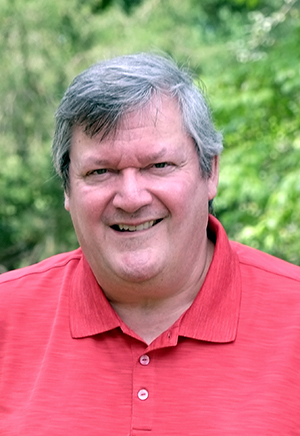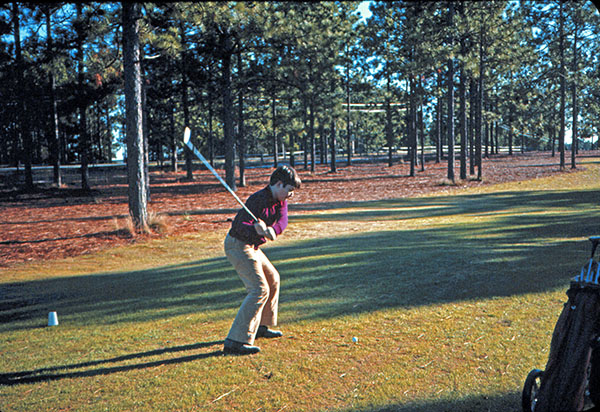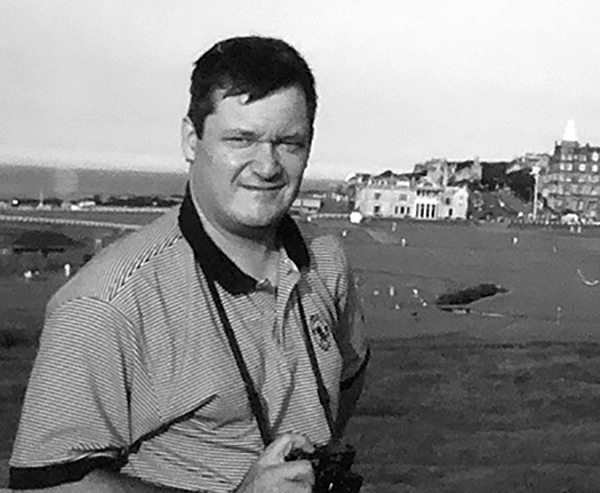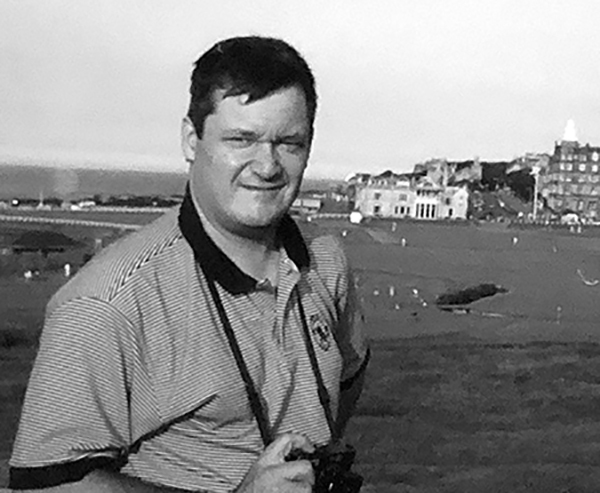Bill Fields

“GHS members appreciate the path to the present.”
– Bill Fields
April 2021
By Sally J. Sportsman

By virtue of his distinguished career as a golf writer, Bill Fields has met and written about many of the game’s greats, including Sam Snead, Gene Sarazen and Arnold Palmer. Fields’s small-town upbringing in North Carolina was a springboard to his opportunity to see the world through golf. While much of his career was spent with Golf World magazine, he also has written for a number of other publications. He has won four first-place awards and received many other citations in the Golf Writers Association of America annual writing contest. As a chronicler of golf through the years, Fields has become a golf historian in his own right, bringing enjoyment to countless readers through his storytelling.
Where were you born, and where did you grow up?
I was born at the hospital in Pinehurst, North Carolina, in 1959 and grew up in nearby Southern Pines. My parents originally were from a tiny community not far away, Jackson Springs.
What is your educational background? When did you become interested in being a writer?
After graduating from Pinecrest High School in 1977, I went to the University of North Carolina at Chapel Hill. I got a bachelor’s degree in Journalism in 1981. I was interested in writing and sports from an early age. We got the Greensboro Daily News at our house, and as soon as I could read, the sports pages were a regular part of my mornings. I was sports editor of our ninth-grade newspaper and from then on, I tried to get all the experience I could. I worked my way up to being sports editor of The Daily Tar Heel at Carolina and also did some stringing for the Associated Press and the Durham Morning Herald.

How were you first introduced to golf, and when did you realize it would be important to you?
I discovered golf as part of a childhood filled with sports. My friends and I couldn’t get enough of whatever sport was in season. My first golf shots were made toward empty cans I buried in our yard. After I became interested in golf, that led to my introducing my father, Gene, to the game when he was about 50 years old. We had a lot of fun playing together in the decade that he enjoyed the game until he died from cancer at age 59.
As an award-winning golf journalist, what are some of your proudest accomplishments?
I’m proud to have been a versatile storyteller over a long period of time, with much of my career spent at Golf World magazine. I joked that my range was 40 to 4,000 words because I did everything from captions and section introductions to columns to profiles. I have enjoyed doing many historical articles and have written about significant golfers from different eras. One of the most satisfying stories was an in-depth look at the late Bert Yancey in 2001. Yancey had bipolar disorder, which made playing the tour very difficult at times. In late March I launched The Albatross, a golf newsletter on the Substack platform, where I write about the game’s present and past.

What has the game meant to you through the years?
I’ve been fortunate to have had most of my working life centered around golf. My career has taken me to 48 states – missing only Alaska and North Dakota – and about a dozen countries. I’ve met some fine people, witnessed some golf history and interviewed others about events that came before my time. For a kid who grew up in a small town but wanted to see the larger world, covering golf has given me a chance to do that.
What is one of your favorite golf memories?
Years ago, on the Monday after an Open Championship at St Andrews, my good friend Jim Moriarty and I played Crail-Balcomie Links. It was a beautiful day, and I got on my knees to play a 1-in-100 shot out of a greenside bunker and pulled it off.
Who was the most fascinating person in golf you have met?
When Sam Snead was 84 years old, I got to spend a couple of days with him while reporting a long feature. We met at his home in Virginia and a couple of weeks later at his winter place in Florida, where we played golf. Sam was still very sharp and had mellowed. He seemed to enjoy the company. We talked about many aspects of his remarkable life and it is one of my favorite stories. Golf writers of my vintage (I turn 62 this year) have been lucky to have had contact with legends like Snead, Gene Sarazen and Byron Nelson, chronicle Tiger Woods from youth to middle age, and now see a new generation on tour.
How did you learn about the GHS and when did you join?
I met Pete Georgiady a long time ago, but it might have been my late friend and former colleague David Earl, with whom I worked at Golf Illustrated, who got me interested in the GHS. David was such an interesting person — professional musician before getting into golf journalism. Tragic that he passed away when he was in his 40s. Dick Donovan was also someone I often contacted because of his extensive knowledge of golf literature.
What is an aspect of golf history that you find fascinating?
The fact that earlier generations of elite golfers could play as well as they did given the limitations of the equipment, the conditions of the courses and the taxing nature of the travel is something I appreciate a great deal. I played in the National Hickory Championship once having never experienced late-19th century clubs and a replica gutta percha ball. Humbling doesn’t begin to describe it.

What kinds of golf artifacts and collectibles interest you?
I have a very small collection of golf balls and some vintage postcards of courses in my home area of the North Carolina Sandhills. I’ve kept almost all of my press credentials. In fact, I’m writing about one in each posting of The Albatross, using it to trigger a recollection of an event, player or experience from a particular week.
Why do you enjoy being a GHS member?
As Dan Jenkins said when asked why he wrote so much about Ben Hogan, “if we don’t tell them, they won’t know.” It’s important that people understand what came before, perhaps more vital than ever because of the quick pace of today. GHS members appreciate the path to the present.

